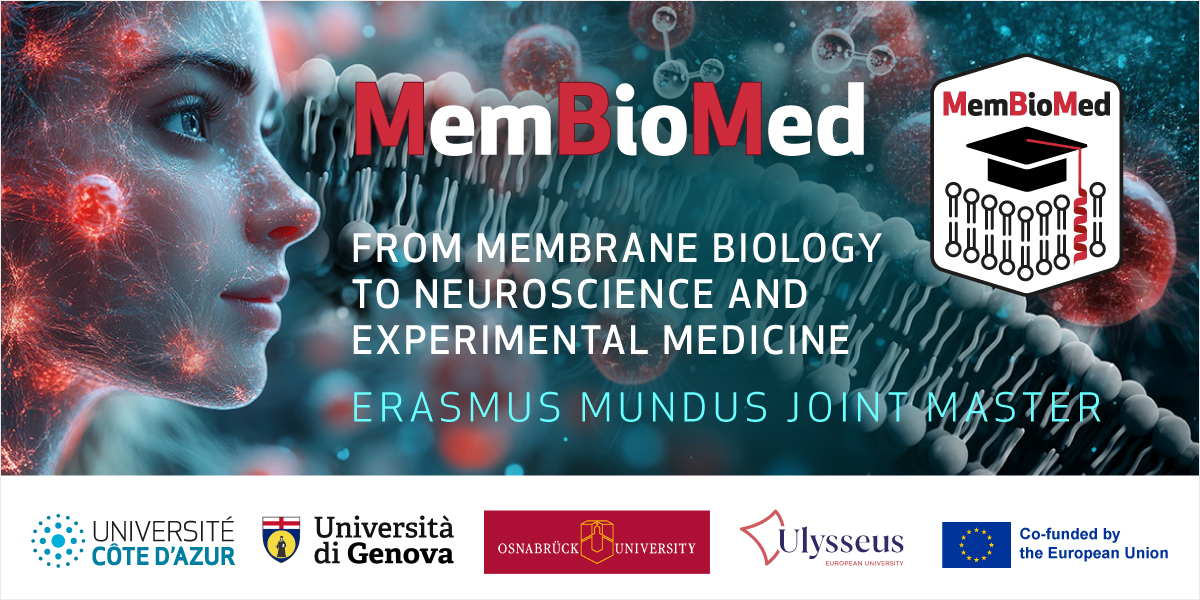Erasmus Mundus Joint Master : MemBioMed
From Membrane Biology to Neuroscience and Experimental Medicine
MemBioMed:
The Erasmus Mundus Joint Master on Biomembranes
A programme designed to prepare a future generation of scientists, entrepreneurs and senior executives for a leading role in studying the complex behavior of cellular membranes and exploiting their full therapeutic potential.
|
Applications for the 2026-2028 MemBioMed Cohort are open from November 1st, 2025 to January 31st, 2026 > HOW TO APPLY < |
What are Biomembranes?

Besides providing semipermeable barriers, cellular membranes are nature’s most sophisticated biomolecular systems that serve vital roles in biogenic processes, energy conversion, information processing and transport.
Consequently, membranes influence nearly every aspect of organismal physiology, making the modulation of membrane-bound molecules a powerful strategy for therapeutic intervention. In fact, drugs that target membrane proteins account for approximately 60% of the international market share of therapeutics.
Consequently, membranes influence nearly every aspect of organismal physiology, making the modulation of membrane-bound molecules a powerful strategy for therapeutic intervention. In fact, drugs that target membrane proteins account for approximately 60% of the international market share of therapeutics.
Why are Biomembranes challenging?
They form collective assemblies of proteins and lipids that are functional over a wide range of time scales and undergo dynamic changes in composition, physical properties and shape in response to a variety of internal or external cues. The lipids can serve simultaneously as solvents, substrates, and regulatory co-factors for membrane protein activity, and these roles are often entangled and overlapping. Classical approaches of molecular cell biology fall short in addressing the intricate relationships among cellular lipidomes, the physicochemical properties of cellular membranes, and the regulation of membrane proteins by either or both. In the field of nanomedicine, drug delivery systems based on biomembrane-derived nanostructures attract increasing interest for their biomimetic properties and potential for clinical translation.

The future of Biomembranes?

As biomembrane research will occupy a central position in biomedical science for many decades to come, it is of utmost importance to train young scientists in this specific field.
A detailed understanding of the pathways and mechanisms that govern the assembly and proper functioning of cellular membranes requires input from multiple disciplines, notably cell biology, structural biology, pharmacology, (neuro)physiology, (bio)physics, (bio)chemistry, and (bio)informatics.
A detailed understanding of the pathways and mechanisms that govern the assembly and proper functioning of cellular membranes requires input from multiple disciplines, notably cell biology, structural biology, pharmacology, (neuro)physiology, (bio)physics, (bio)chemistry, and (bio)informatics.


Funded by the European Union. Views and opinions expressed are however those of the author(s) only and do not necessarily reflect those of the European Union or the European Education and Culture Executive Agency (EACEA). Neither the European Union nor EACEA can be held responsible for them.
“The European Education and Culture Executive Agency (EACEA), in the context of managing the Erasmus Mundus Joint Masters, collects and processes the personal data of some of the candidates. In particular, certain data of the scholarship holders and non-scholarship holders is shared with the Agency and treated according to this privacy statement”
“The European Education and Culture Executive Agency (EACEA), in the context of managing the Erasmus Mundus Joint Masters, collects and processes the personal data of some of the candidates. In particular, certain data of the scholarship holders and non-scholarship holders is shared with the Agency and treated according to this privacy statement”






